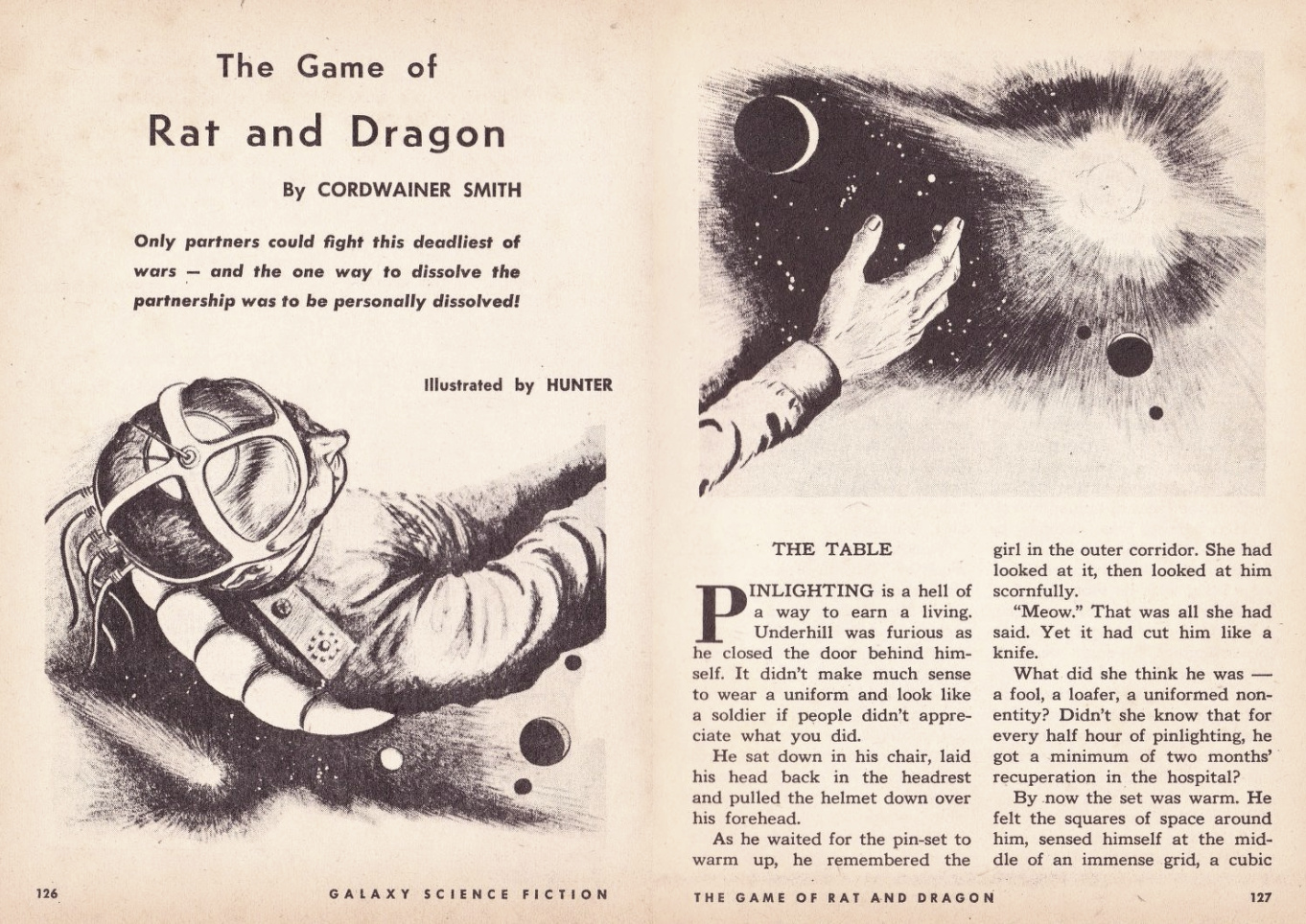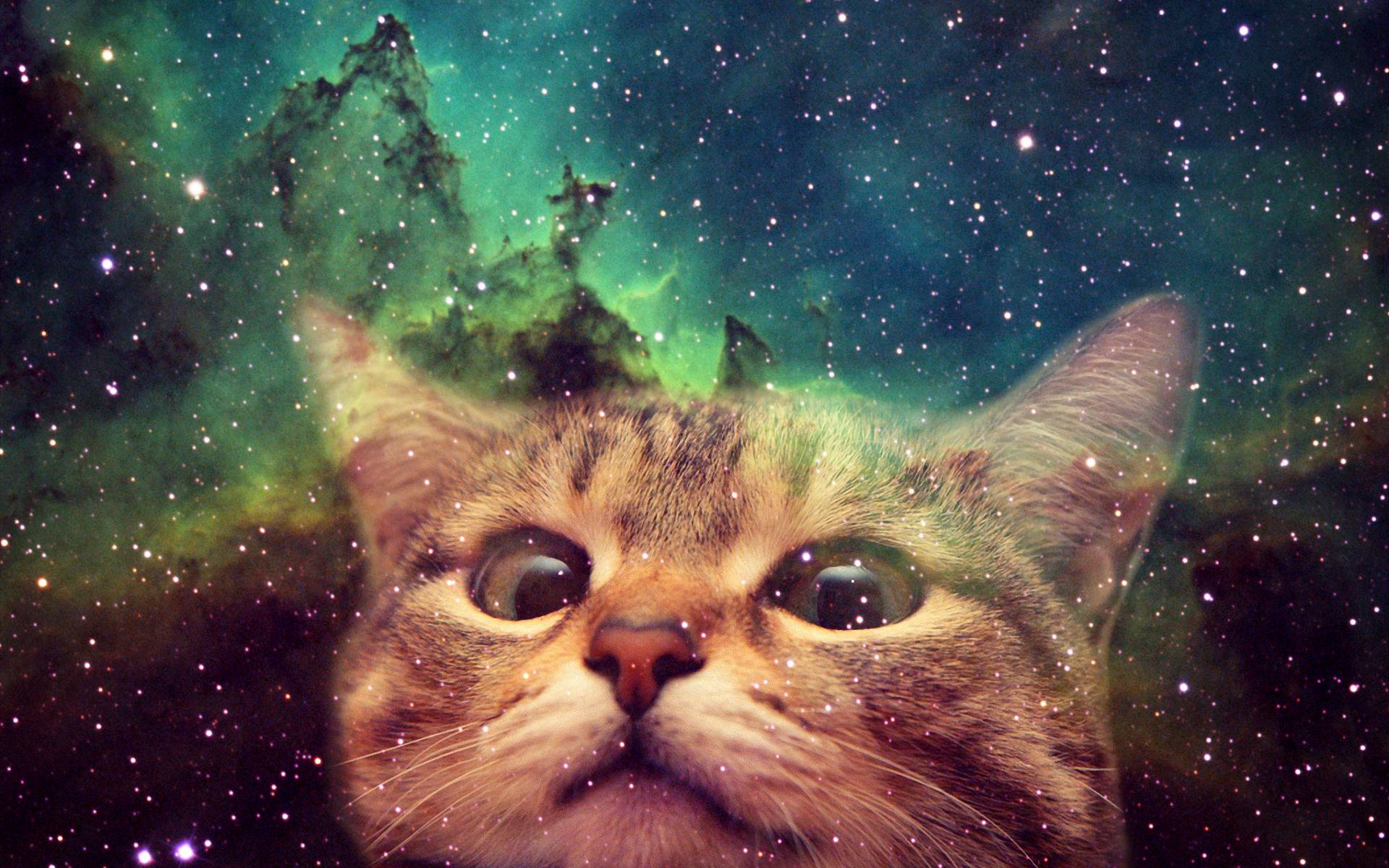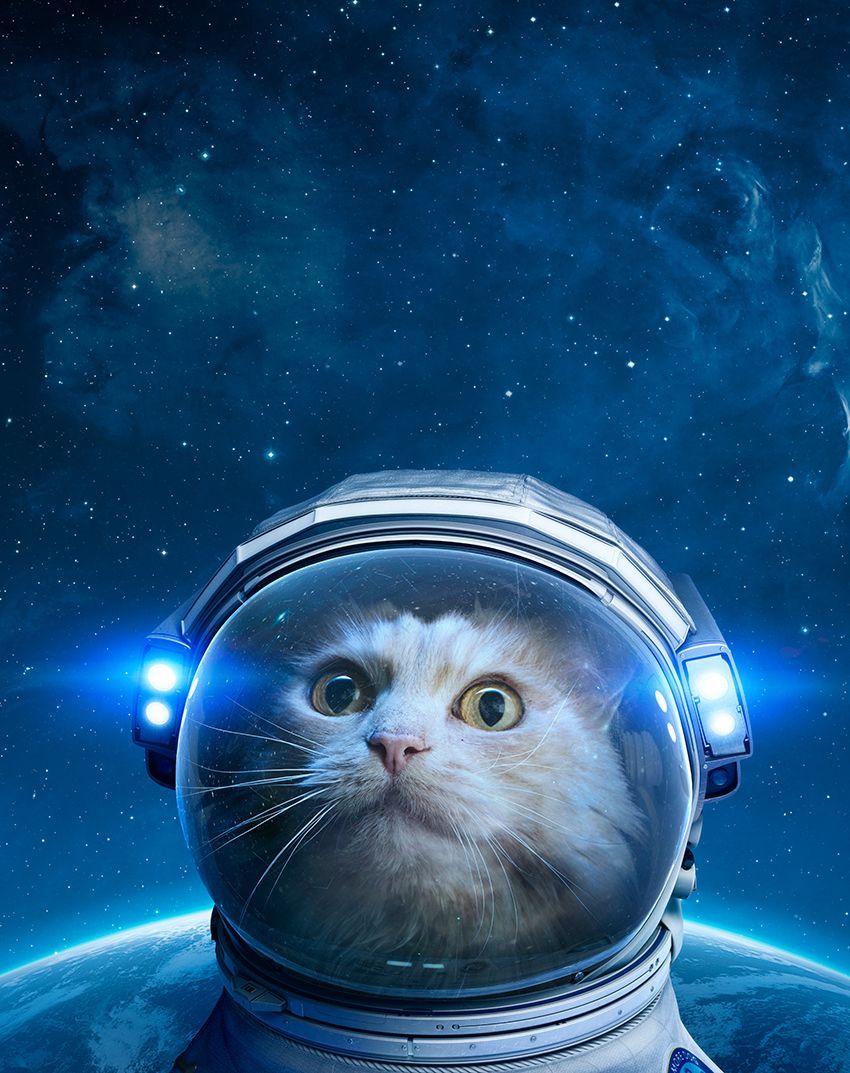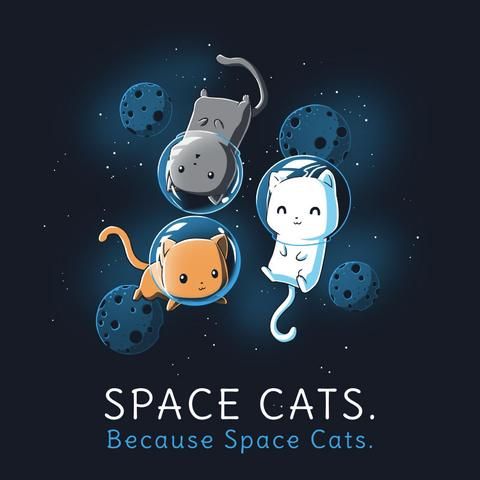A week ago we kicked off Bud’s Book Club with a short story, The Game of Rat and Dragon, and a non-fiction book, Man-Eaters of Kumaon. This post deals exclusively with the former. (If you haven’t read the story yet, it’s available here free. Most people will be able to read the story in less than a half hour at a moderate reading pace.)
By now everyone who’s read the story knows what it’s about: Cats, of course! But the story requires a bit of world-building setup before the kitties are introduced:
In an unspecified future humans have become a true spacefaring species, mastering interstellar travel and founding colonies in new star systems.
It’s a lot like the days of colonial powers founding settlements in the New World, but without the ugliness of terrestrial colonization or the quaintness of crossing a mere ocean.
Using a form of traveling called planoforming — essentially faster-than-light (FTL) jumps — human ships are able to reach distant star systems without traveling for the decades or centuries it would normally take to cross the unfathomable distances between solar systems.
Just when it looks like no obstacle remains for humanity to spread out into the galaxy, the intrepid explorers on the rim of human-occupied space realize there’s an insidious threat lurking in the void between stars.
Huge entities, invisible to the human eye, live in the vacuum of the interstellar medium. They haunt the void and attack human ships without warning. They are “beasts more clever than beasts, demons more tangible than demons, hungry vortices of aliveness and hate compounded by unknown means out of the thin tenuous matter between the stars,” author Cordwainer Smith writes.
When the mysterious entities attack, most people are mercifully killed in an instant, but the unlucky ones survive in a permanent state of insanity, their minds unable to cope with whatever alien malevolence they’ve witnessed.
As they learn more from each disastrous encounter, humans come to understand these creatures prefer the deep dark, shying away from star systems and their abundant sunlight.
But without a way to make it across the void, it becomes clear the era of human exploration and colonization is over unless something can be done to stop the enemy.

To extend the nautical theme, you can think of the dragons as giant krakens who prey on trade ships and passenger liners crossing between the American colonies and Europe during the Age of Sail. Although pushing the boundaries of new frontiers has always been dangerous, you can imagine how quickly intercontinental trade and settlement would grind to a halt if, say, half of all ships were sunk en route.
Humans can’t see the dragons, but that isn’t the primary reason they can’t successfully fight them. After all, the history of human warfare proves we’ve become adept at destroying enemies we can’t see, whether a ship’s dropping depth charges on a submarine hidden in murky waters, or some 20-year-old kid on an aircraft carrier hundreds of miles out to sea is using a joystick to lob drone-fired missiles on mainland buildings.
The real problem is that people just aren’t quick enough, unable to target and fire on the dragons before the entities react and speed away to safety.
So they turn to cats.
Kitties to the rescue
With their incredible reflexes, reaction time and hunting instincts, cats are more than a match for the dragons, and here’s where the story starts to get really fun. Cats, we’re told, travel alongside human vessels in their own little football-shaped ships that are equipped with precision miniature nuclear warheads.
Cats are happy to destroy the dragons — if their humans present the conflict as a game, make the “dragons” look like rats, and offer substantial rewards in the form of fish and poultry.

That’s why the cats are called Partners: Using some sort of brain link, specially trained humans pair up with the cats, mentally project images of the dragons as “gigantic rats,” and act like spotters so the kitties can pounce on their space rodents before the latter can hurt the human passengers.
Because the dragons are harmed by light, the cats lob “ultra-vivid miniature photonuclear bombs, which [convert] a few ounces of a magnesium isotope into pure visible radiance,” neutralizing the threat before anyone can be harmed.
The mind link between human being and cat is a two-way connection, affording cats a close-up view of human thought patterns just as the humans can feel the kitty’s mental processes.
We learn that our hero, Underhill, loves the feline Partners, and he’s deeply offended when a fellow soldier mocks his work by meowing at him. We also learn the cats understand that, while their task is dressed up as a fun hunting game, they face real danger when they fight the dragons.
The mind of a cat
Through Underhill’s eyes, we meet several of the Partners.
My favorite is an unnamed tomcat, described as “a greedy old character, a tough old male whose mind was full of slobbering thoughts of food, veritable oceans full of half-spoiled fish. Father Moontree had once said that he burped cod liver oil for weeks after drawing that particular glutton, so strongly had the telepathic image of fish impressed itself upon his mind. Yet the glutton was a glutton for danger as well as for fish. He had killed sixty-three Dragons, more than any other Partner in the service, and was quite literally worth his weight in gold.”

We’re told that the cats recognize the complexity of human minds, but aren’t necessarily impressed by them. The things humans concern themselves with and worry about are “silly” from a cat’s perspective (which, perhaps not coincidentally, is how the philosopher John Gray imagines how cats view us), and cats can quickly grow bored with a human too focused on highly abstract thoughts or subjects that simply don’t have much bearing on feline life:
“Usually the Partners didn’t care much about the human minds with which they were paired for the journey. The Partners seemed to take the attitude that human minds were complex and fouled up beyond belief, anyhow. No Partner ever questioned the superiority of the human mind, though very few of the Partners were much impressed by that superiority.
The Partners liked people. They were willing to fight with them. They were even willing to die for them. But when a Partner liked an individual the way, for example, that Captain Wow or the Lady May liked Underhill, the liking had nothing to do with intellect. It was a matter of temperament, of feel.
Underhill knew perfectly well that Captain Wow regarded his, Underhill’s, brains as silly. What Captain Wow liked was Underhill’s friendly emotional structure, the cheerfulness and glint of wicked amusement that shot through Underhill’s unconscious thought patterns, and the gaiety with which Underhill faced danger. The words, the history books, the ideas, the science—Underhill could sense all that in his own mind, reflected back from Captain Wow’s mind, as so much rubbish.”
Underhill is as fond of Captain Wow and Lady May, a friendly Persian, as they are of him. He’s happy when he’s called upon to defend a ship and finds out he’s been paired with the latter:
“When he had first come into contact with her mind, he was astonished at its clarity. With her he remembered her kittenhood. He remembered every mating experience she had ever had. He saw in a half-recognizable gallery all the other pinlighters with whom she had been paired for the fight. And he saw himself radiant, cheerful and desirable.”

What’s unique about this story — and what makes it particularly memorable, in my opinion — is Cordwainer Smith’s decision to explore the feline mind.
Out on a limb, from a feline world view
Minds, human or animal, are called “black boxes” for a reason. Even with the benefit of advanced science, even with fMRI and other forms of imaging, even with algorithmic AI that can read thoughts and sketch rudimentary images from our minds, we really don’t know what others are thinking, human or animal.
Smith goes out on a limb by imagining what must go on in the minds of cats, and it’s obvious he’s not only a cat lover, but he had a lifetime of experience with our furry friends when he wrote the story.
The idea that cats are all about emotion and tangible things — and are bored by things humans concern themselves with — seems dead on, as does the idea that cats aren’t impressed by our intellectual superiority, which only counts as superiority in human terms. Even if they had opposable thumbs and the means to create, would cats be interested in the kind of things we do?
Probably not. God only knows what kind of structures cats might build and what songs they’d write, but I’m pretty sure my cat would write paeans to turkey.
Did you like the story? What are your thoughts?


I never read the story, but my father probably did. He had a whole collection of these old SciFi books from that time frame, and loved cats. It is an interesting synopsis you have written here.
LikeLike
If he had digests from the 50s and 60s then he almost certainly would have had this one. Some of those old SF digests are still around today as web magazines, and pretty much every big name science fiction author came up publishing short fiction in those publications. The medium has changed, but the spirit of science fiction has not, and the best SF stories remain the ones that use exotic settings and future tech to reflect on human nature.
LikeLiked by 1 person
Cordwainer Smith – real name Paul Myron Anthony Linebarger – was a very interesting guy. Both an authority on East Asia and an expert in psychological warfare. Add to that, if you google him, what will pop up is a photo of him holding a cat.
LikeLike
Thanks for pointing that out. I ran a search after I read your comment and found that photo, plus another where he’s holding two black kittens, and a third in which he’s holding what looks like an orange tabby. (Hard to tell since it’s black and white.) Smith/Linebarger clearly loved cats.
LikeLike
Until the rich and greedy among us can learn to stop plundering the planet we’re on, which meets our needs exactly, I don’t want humans to spread across across the galaxies like cockroaches. Good riddance if they’re wiped out in the Great In-Between, and the rest of them are insane already with their homegrown form of evil. So they meet the inevitable “bigger and badder than they are”? Too bad.
LikeLike
I have been a huge Cordwainer Smith fan since the early 70s. His take on cats has always been one of my favorites.
LikeLike
He’s fantastic, and I agree, he knows his cats.
We’re gonna do Space-Time for Springers soon for the book club. I imagine since you’re a Smith fan you’re also familiar with Fritz Leiber, but on the off chance you’re not, STfS is another magnificent science fiction short story featuring cats, and was first published in Ballentine’s Star Science Fiction Stories #4 in 1958.
You’re more than welcome to join us in this unofficial book club. The plan is to give people a week or so for short stories, and a few weeks for novels. Cheers!
LikeLike